Ladies, I’m just going to be honest with you. Back labor sucks. It hurts, and it hurts worse than regular labor. But hang with me, because in this blog post I’m going show you how to rock back labor like a boss. You can do it!
How to Rock Back Labor Like a Boss
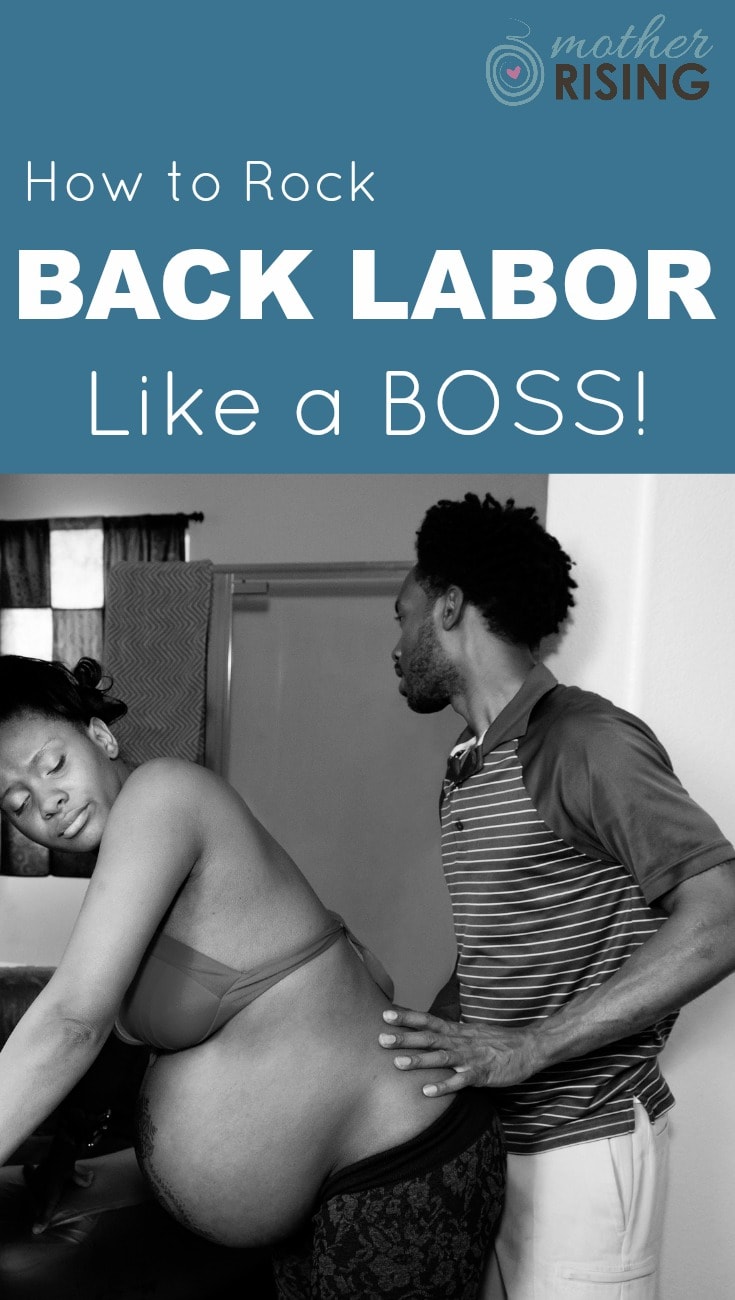
Sign of Labor: Back Pain with Contractions
With my first child, one of my first signs of labor was light contractions that woke me up accompanied by mild back pain each time I had a contraction. At the time I didn’t know if I was in labor or not, as I had been contracting lightly for weeks. But this time things seemed different – the contractions were annoying enough to keep me awake, but I also had a sensation of pain in my back during each.
Turns out I was indeed in labor, and that the pain I was experiencing in my back would turn into full blown back labor. Yippie!
What Does Back Labor Feel Like?
For me, back labor felt like this: I would begin a contraction and I would feel my belly tighten as usual. Any sensation of cramping, pressure or pain would begin in my belly, but then slowly spread to my back. At that point, my focus was completely on my back as that sensation completely dwarfed any sensation in the front.
Back labor completely dominated my labor pain. If I was having pain in the front, I wasn’t really aware of it. All I could think about was the hot, burning pain in my back.
As labor progressed, my contractions became stronger and closer together and my back labor became more intense.
In early labor, back labor was completely manageable. It felt like normal, annoying back pain. As things progressed to active labor and transition, that’s when I needed more help and ideas as to how to cope.
What Causes Back Labor
Before we get into how to fix back labor and cope with back labor, let’s talk a little bit about what causes back labor.
Baby’s Position
Often, back labor is caused because the baby is “in a wonky position”.
The optimal position for a baby to be in is head down, facing mom’s back with the chin tucked. Spinning Babies has a great photo of this ideal position, called left occiput anterior (LOA).
If the baby is not in this position, but in a posterior position (occiput posterior) or “sunny side up” (baby is facing forward and the back of its head is near mom’s spine) the back of baby’s head can put an extraordinary amount of pressure on mom’s back. Ouch!
Short-Waisted Women
Women that are short-waisted may experience back labor because their baby is longer than their torso. During each contraction there is a downward force, but instead of the baby pushing down on the cervix, because of the lack of space, the baby pushes down on mom’s back. Ouch!
Have no fear, there’s any easy fix for this. Scroll down to the “abdominal lift and tuck” below.
Tight Ligaments
Another reason for back labor, according to Spinning Babies, is tight ligaments. If this is the suspected cause of back labor, I highly recommend the sidelying release.
How to Fix Back Labor
Change Positions
If the baby is in the wrong position, whatever the cause may be, the best way to move the baby is to move the mother.
🎶If you can’t move the baby, move the mother!🎶
(Sing this to the tune of 🎶 “If You’re Happy and You Know it”🎶. You’re welcome. Your solution will now be stuck in your head!🎶)
Abdominal Lift and Tuck
If I were experiencing back labor, knowing what I know now, I would try the abdominal lift and tuck first. After reading the quirky book, Back Labor No More, here’s what I learned.
- This technique is most helpful for shorter women
- After using this technique, labor can progress rather quickly
- Try this technique for at least 10 contractions before moving on to something else
To do an abdominal lift and tuck, do the following while you have a contraction:
- Stand up.
- Bend the knees a little.
- With both hands gently lift the belly up.
- While lifting the belly, rock the pelvis forward as if you’re bringing the pubic bone closer to the belly. The lower back should flatten or become more straight.
- When the contraction goes away, gently release the belly and pelvis.
- Do this for about 10 contractions.
Hands and Knees
Another position to try to eliminate back labor is hands and knees. This position is helpful because it takes the pressure of the baby off mom’s back and can encourage baby to rotate into a better position.
It’s also an easy, quick position to get into no matter where mom is at – bed, floor, tub, wherever.
(Hands and knees also one of my favorite birthing positions!)
Exaggerated Sims
If you’re getting serious about eliminating back labor and are ready to do whatever, the exaggerated sims position will possibly do the trick. This position has also been called the “running man” or “titties to the mattress” or TTM.
Before getting into this position, it’s important for the mother to know why she’s doing this position and how long she will be in this position. This position sucks while in labor, especially if she’s in transition. Ask me how I know.
During the birth of my son, there was a period of time where it seemed as though I was stuck at 8 cm. After a vaginal exam, my midwife thought that my baby was not in the ideal position and that once he was I would continue to progress to 10 cm, pushing and then a baby. That all sounded great to me, so I went along with what she proposed. She proposed the exaggerated sims position.
The exaggerated sims position helps by encouraging a baby to rotate from a posterior position to a more favorable position facing the mother’s back.
- The first thing I was required to do was to get on the bed. Which required me to lift my leg. For the life of me I couldn’t do it! I was in so much pain that I could not fathom lifting my leg and hoisting myself on the bed. After standing next to the bed for multiple contractions, unable to get on the bed, my midwife and husband hoisted me on the bed.
- After that, I positioned myself on the bed much like the women in the picture below. Except she looks much more comfortable than I felt. She looks like she’s sleeping. I, on the other hand, was holding on to the bedrails above my head for dear life.
- I can’t remember how many contractions I endured while in this position. But it seemed like forever and it was awful. I realize I’m likely not sounding very encouraging, I’m just trying to be honest. However, it was worth it because after a good while of doing this (maybe 30 minutes?) I had another vaginal exam and it seemed that my baby had turned.
However, my back labor did not stop, which was disappointing.
(credit: https://www.milescircuit.com/the-circuit.html)
Miles Circuit
If I had a time machine, I would go back to my first birth and try the Miles Circuit instead of simply the exaggerated sims position. Alas, I did not have a doula and my husband had no clue. I doubt at that time my midwife knew about the Miles Circuit.
The Miles Circuit is helpful because it prepares your body and baby for the exaggerated sims position, but then after the exaggerated sims, it attempts to get the most bang for your bucks assuming your baby has rotated.
(For really good instructions on how to do the Miles Circuit, head on over to their website.)
Miles Circuit Instructions:
- Eat, drink and go to the bathroom. Prepare yourself to be in one position for a good bit of time.
- Spend about 30 minutes in the open knee chest position. This will gently and slightly lift the baby out of the pelvis to help create space for baby to rotate.
- Spend an additional 30 minutes in the exaggerated sims position as outlined above. This position, accompanied by contractions, will encourage a baby to “spin” or rotate into a more favorable position.
- Spend the final 30 minutes in upright positions that open the pelvis like side lunges, climbing stairs sideways or curb walking. Make sure that you switch sides so that each side of the pelvis is opened up. It’s important to be balanced!
Back Labor Comfort Measures
Sometimes, no matter what we try back labor just doesn’t go away until the baby is born. If this is you, I can empathize. My back labor didn’t go away.
In fact, I felt it acutely even while pushing, which surprised me. Every time I pushed my baby down, the back labor would go away, but between contractions my son would come back up some (which is a normal part of pushing, especially for a first time mom). When he would come back up, my back labor hurt like the dickens! I tried so hard to keep him down between contractions, but it didn’t really work. Not until he was born did my back labor go away.
If you’ve tried to get rid of your back labor, but it didn’t work, have no fear! The following comfort measures are VERY helpful for back labor.
Counter Pressure
Counter pressure is an excellent method of relieving back labor, or at minimum, lessening the intensity of back labor. Generally speaking, there are two types of counter pressure – the double hip squeeze and sacral pressure.
TIP: Partners, if counter pressure ends up working you’ll likely be doing counter pressure for the rest of the birth experience. To save your energy, don’t offer this as an option until it’s absolutely necessary! You’ll be VERY sore the next day. 🙂
Double Hip Squeeze
The first method of counter pressure is the double hip squeeze. Have your partner or other birth companion gently squeeze the hips in and pull ever so slightly back away from mom.
TIP: Ladies, if this is helpful say “yes”, if you need more or less pressure say “more” or “less”. If this is awful say “stop”. When in labor land, the less words required to communicate the better.
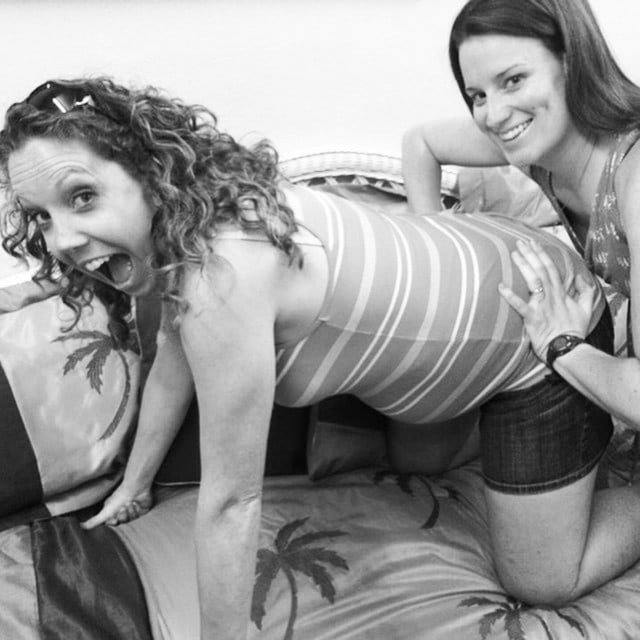
Sacral Pressure
The next method of counter pressure, and what I think is the best method of counter pressure for back labor, is sacral pressure. The sacrum is a flat bone directly above the butt crack. Partners, place the palm of your hand on the sacrum and press in towards mom.
Again, if this is helpful say “yes”, if you need more or less pressure say “more” or “less”. If this is awful say “stop”.
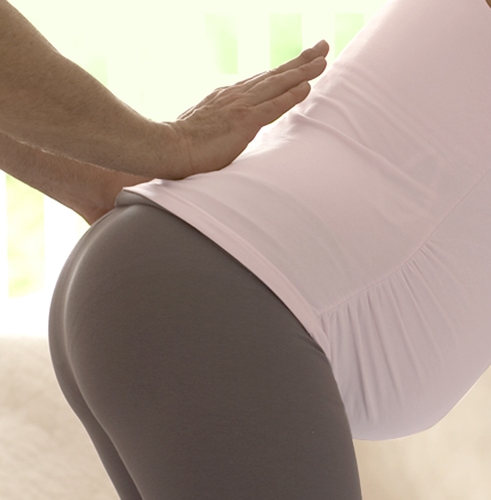
Heat and/or Cold
Next, in the back labor artillery, is using heat and/or cold on the back.
My local hospital offers its patients microwave safe gel packs to use for back pain. Simply microwave for 30 seconds up to 1-2 minutes (depending on the strength of the microwave) and you’re good to go! When the gel pack is freshly heated, place the gel pack in a pillow case to prevent it from being too hot on mom’s skin.
A hot water bottle is also an effective tool to soothing back pain in labor. It holds its heat much better than a gel pack.
This same gel pack can be placed in the freezer and used on the back in the same way. However, when using a frozen gel pack you’ll need more than one. Once one gel pack has thawed, but it back in the freezer to re-freeze and grab another one to keep her back cold.
*Please note that if you have an epidural using heat or cold on the back could be unsafe as you won’t have adequate sensation to determine if it’s too cold or hot.
Another way to use heat to relieve back labor is by using a shower or tub. See below for all the details.
Tub
For my first birth, I had high expectations for using a bath during labor. After all, I was told that a waterbirth was a “natural epidural”. Well, it was nowhere close to feeling like an epidural for me. I even tried submerging my entire body (head and all) to get the full effect. Nope, I still felt my contractions and my back labor. Boo.
However, I did find one thing about the tub to be helpful. When my husband poured very hot water on my back, I felt relief from my back labor. Yes!
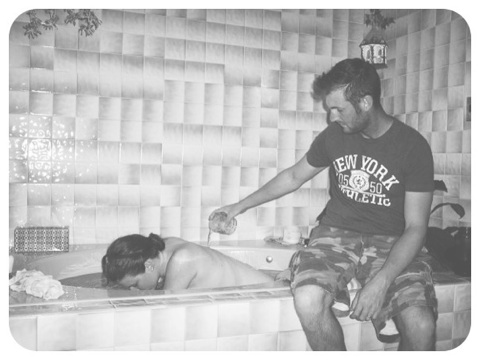
However, left to my own devices I made my entire bath scalding hot which turned out to not be good for my baby. This elevated his heartbeat and I had to get out and cool my body down. Ooops!
To avoid this birth blunder, the bath water should be body temperature only. Once the tub is filled, hot water can be poured on mom’s back. I think that’s a fair compromise.
Another way a tub is helpful is that it allows the mom to be in the hands and knees position, but the water helps her hold herself up. Which can be so helpful in labor! Anything to make mom’s job easier is a win.
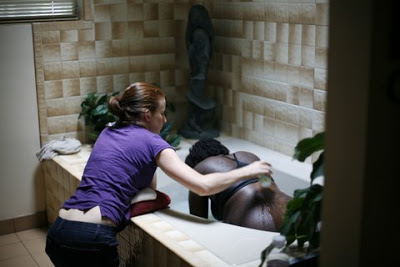
Shower
Another comfort measure for back labor is the shower. The benefits of a shower in labor are similar to the tub – hot water on the back. Aim the water on the back for the maximum effect.
A quick google search found me these beautiful birth photos of women using the shower in labor. I love birth photos!
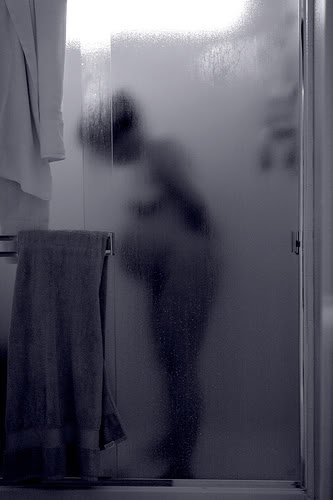
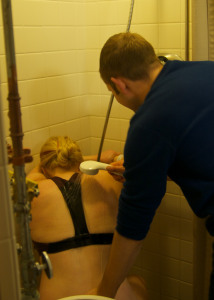
(Here’s photo credit)
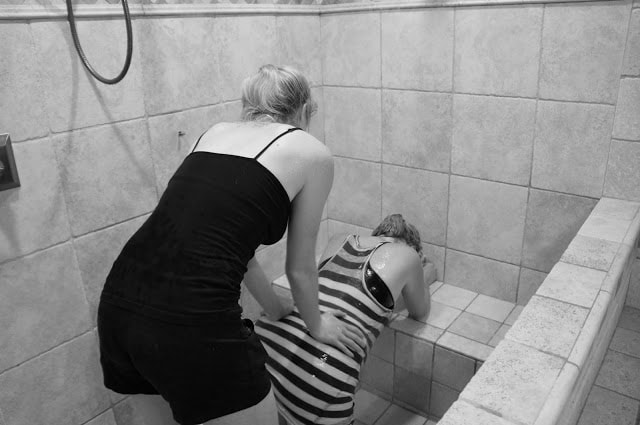
(Click for photo credit)
TENS Machine
The next thing on the list of comfort measures for back labor is a TENS machine.
According to FitPregnancy, “The TENS works by sending electrical nerve stimulation through these electrodes; it doesn’t take away the sensation of contractions, but essentially interrupts the pain signals your brain is receiving, possibly reducing your awareness of them or producing endorphins that allow you to cope better. It’s a common comfort measure used in physical and occupational therapy, especially by people who suffer from chronic pain.”
Unfortunately, and maddeningly so, a TENS machine is not approved by the FDA for pregnancy. That’s why you won’t find products like the Femme Tens for sale in the US and articles about how to use the TENS will use words like “labour”. 😉
If you want to use a TENS machine for labor, you’ll either have to buy one from another country (Canada or the UK are good choices) or buy a TENS machine that is not marketed specifically for pregnant women.
TIP: For maxium benefit begin using the TENS machine earlier in labor. If I had a TENS machine for my first birth, I probably would have began using it at home, before I went to the birth center.
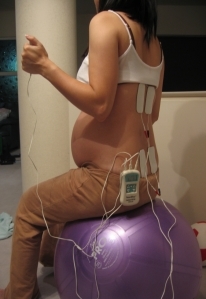
(image credit: https://www.easybirth.com.au)
Sterile Water Injections
Another comfort measure to consider for back labor is sterile water injections. Literally, sterile water is injected in four places on the mother’s back. Sterile water injections are helpful because it blocks, or slows, the message being sent to the brain that the back is in pain.
My sister-in-law (in Iowa) used sterile water injections for her back labor with her first child. She said that getting the injections was extremely painful. Extremely. But the relief that followed was glorious, however, from her experience short lived. She said she had a few more contractions (maybe 15 minutes?) of relief. This website says relief will last 90 minutes.
The back labor pain must be far greater than the pain received from sterile water injections in order for this procedure to be helpful. My sister-in-law said it felt like bad wasp stings.
Here are some tips for care providers on the administration of sterile water injections.
a) Use fine needles 25gauge
b) Use 0.1mL of sterile water (yes, that’s all)
c) Get the woman to point to where the pain is worst, inject her there
d) Two midwives administer the water at the same time – the sting may stop the woman from having the other side done if only one midwife does it.
e) Have the partner hold the woman’s hands and talk her through the injections as she can automatically swipe at you when you give the injections
f) Administer the water injections into the skin, it’s intra – dermal, not sub cutaneous, not under the skin, the idea is to raise a little bleb which stretches the skin and sets off the receptors
g) Leave the area alone! the sting is the thing, if you rub it, it will lose its effectiveness.
h) The Swedish midwives give four injections, either as four in a row across the back, or on the four points of an inverted trapezpoid shape on the woman’s sacrum. (source)
Epidural
Last but certainly not least, the epidural is the mother of all back labor comfort measures. The epidural works by numbing the laboring mom from the belly on down. It is effective at relieving pain, but it comes with its share of risks and complications.
- In my experience, the epidural can slow labor progress, especially when the baby is in an unfavorable position. Once an epidural is placed, a mother can not move her pelvis/body as in a normal unmedicated birth. On average, pushing a baby out takes more work and time with epidural and if the baby is in a bad position, an epidural only exacerbates this issue. In this scenario, and in my experience, the chance of a cesarean has increased.
- A peanut ball is helpful when using an epidural as it will help mom to open her pelvis even when in a hospital bed. When the pelvis remains open, it creates space for the baby to rotate.)
- Also, in my experience, an epidural also increases the need for pitocin. Pitocin, comes with its own risks and complications.
- If a mother is hoping for an unmedicated birth out of the hospital, obviously getting an epidural will majorly change her plans. It is important to exhaust all other options before opting for an epidural.
Dont’ get me wrong, I’m definitely not anti-epidural. I truly believe that epidurals can be used with wisdom and compassion. Only you and your birth team will be able to determine when that becomes the case. An epidural can absolutely be the next best thing!
How to Rock Back Labor like a Boss
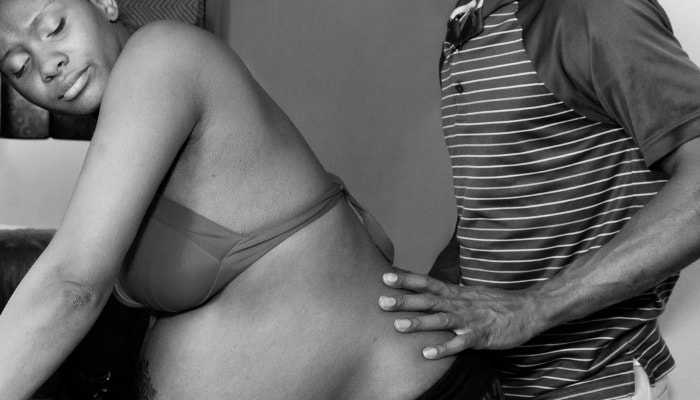
To recap, here are proven tips and tricks to rock back labor like a boss.
- Change positions
- Abdominal life and tuck
- Hands and knees
- Exaggerated sims
- The Miles Circuit
- Counter pressure
- Heat and/or cold
- Tub
- Shower
- TENS machine
- Epidural with a peanut ball
If you’ve experienced back labor, would you please leave a comment and let me know what worked and didn’t work for you? I’d love to hear from you!

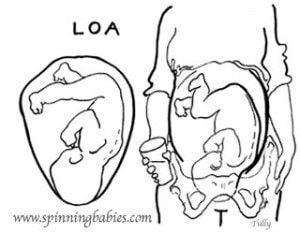
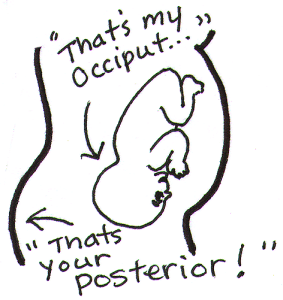
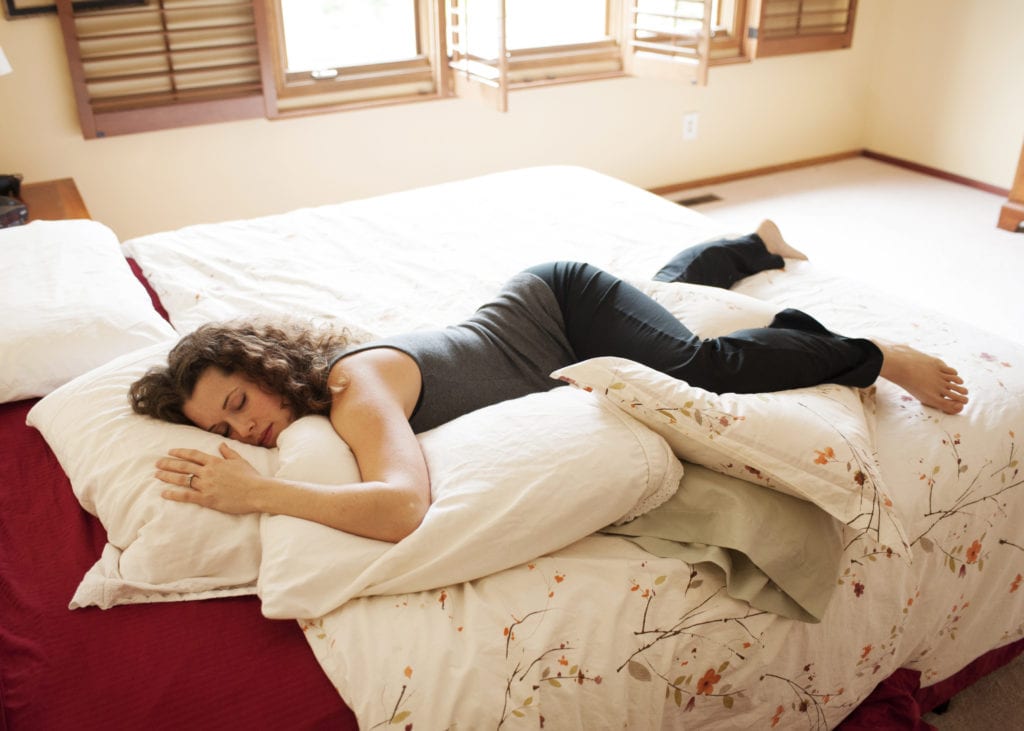
Jessica
Wednesday 25th of September 2019
This article was so validating. I too had back labor with my first, suffered with it until I did get epidural -but it didn't help! Epidural took away my abdominal pain (which like you so well described, I wasn't even aware of due to the overwhelming, excruciating lower back pain) but it did not fully relieve the back pain (maybe a little?). I was able to tolerate it but I was still whimpering until the very end. I have heard since that epidural does not always relieve back pain. I am encouraged by the women who write that the second time around they did not have back labor. I am hoping for that as a best case scenario. However, I am short in height, and I feel that the back labor was not due to baby's position but due to my figure and unique way of carrying the pregnancy. I definitely was not told that the baby was sunny side up, rather I was told that the baby's position was excellent for birth. Which is why I'm here reading this article...trying to gather info in case of another back labor birth (due date coming up soon!) I have one question- While in labor, whatever I knew about labor positions flew out the window once the back pain overtook every bit of brain space I had. So reading about the abdominal lift and tuck gives me hope, but at the same time I don't think I will have the ability to actually try it while dancing from the pain. I can't imagine remembering/following through based on how my birth was last time. Any suggestions?
Lindsey VanAlstyne
Thursday 26th of September 2019
I would educate your support team of your wishes and show them how to do the abdominal lift and tuck on your body. It's totally a thing. Dads, especially, are great at this as they typically have more endurance than others in the room!
Emma
Thursday 7th of February 2019
I tried all of these in labour , the back and rectum pain was unbearable. I laboured at home painfully until 5cm then needed the epidural for the pain. I had to be put on oxytocin drip as waters broke over 24 hours b4. Stopped epidural two hours b4 pushing and they increased oxytocin to max so painful. Needed forceps in the end . Baby fine :-)
Bridget
Tuesday 27th of November 2018
I had terrible back labor and it was my first. I distinctly remember asking my mom why it wasn’t stopping, she laughed at me and told me I was in labor and it wasn’t supposed to. I told her she was lying and in all the birthing classes they told me I would have a break in between contractions and I never did I made it to 7 1/2 centimeters then told hubby to stop touching me, that’s when I got the epidural. I wish I knew all this then. I can’t wait to have another baby but I am dreading back labor again!
Lindsey
Tuesday 27th of November 2018
My second birth was completely different than my first. No back labor! You can do this!
amanda
Sunday 20th of May 2018
Thanks for this! I'm only 5w pregnant but I'm already dreading having another labour with back pain, that last time, ended up as an attempted forceps/emergency caesarean delivery. I spent literally all day in the birthing pool at the hospital but once my waters had been broken for too long I had to get out and the shower wasn't cutting it. I was extremely disheartened to learn I wasn't fully dilated after 30+ hours. The back pain had just turned into a constant spasm that had zero breaks between contractions. The epidural I got in the operating theatre was the most heavenly experience I've ever had, but I would really like to avoid all of that next time around.
I tried a lot of things on your list but this gives me a few more options! I hadn't heard of the abdominal lift and tuck at all before. I might take my husband along to an acupressure session so we can master the sacral and hip tricks. Thanks again :)
Lindsey
Monday 21st of May 2018
I'm happy you found this encouraging! The tiniest bit of hope makes all the difference.
Kate
Thursday 26th of April 2018
This article was a god send. I’m pregnant with my first and was up most of the night with back labor which is still on going. The circuit is working pretty well and I was actually able to get some rest with a child’s pose on the bed with my chest and tummy supported by pillows. Also side laying with heat was working. The only challenge is when the positions stop working and I have to pick a new one. However as the article promises I’m managing this back labor like a boss now :) printing this sucker out and using it until the baby comes